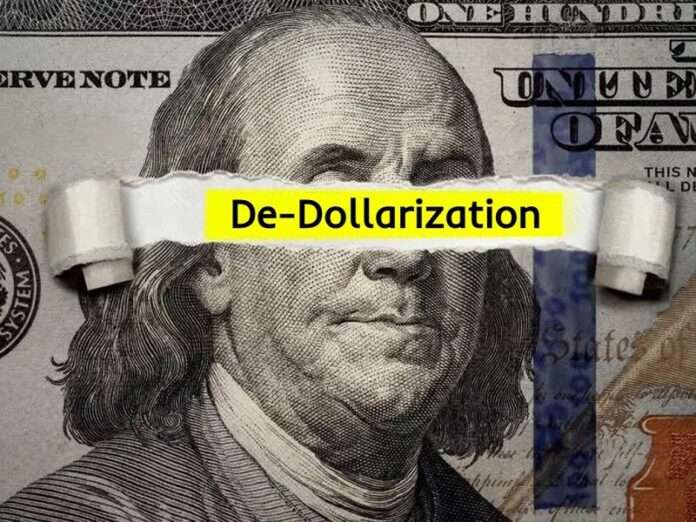The Hindu Business Line cited an unnamed official to report on Monday that October’s BRICS Summit in Russia’s Kazan might see a non-binding agreement on de-dollarizing trade between member states. They also claimed that the much ballyhooed “BRICS currency” will be notional and have its value derived from a basket of currencies. What follows are their source’s exact words, which will then be analyzed in order to place them into context and assess the viability of these reported proposals:
“New Delhi is examining an appropriate response based on the extent to which it would benefit economically and diplomatically from the proposals without increasing its vulnerabilities vis-a-vis China.
It is each according to its comfort level. Within BRICS if you agree for currency settlement, you may choose not to do with x country, while doing with others.
If India chooses not to do with China in yuan and rupee, it is okay. But it may do with other countries, for instance the rouble or rand. For instance, Russia can ship out the surplus rupee that is collected in its vostro accounts in India, convert it into Brazilian [reals] to pay Brazil for some transaction. Or it can convert it into South African rand to make payment to South Africa.
The BRICS currency will be a notional currency and not a currency in physical form. The issue is how does one peg the value for it. Naturally, the value will derive from the value of all the currencies in the basket put together. Notionally, one gets the impression that yuan is a dominant currency. So, it will have a greater weightage. India has to see whether that will be acceptable to it.”
For starters, BRICS is a voluntary collection of countries with a shared interest in accelerating financial multipolarity processes. It doesn’t have a secretariat nor even a charter, but its joint statements throughout the years enable observers to obtain an understanding of its working culture. There’s no mechanism to enforce compliance with their declarations so cooperation has to be built on trust. That’s why everything that they agree to is already non-binding and always will be.
This is very relevant as regards their members’ shared goal of de-dollarization. India is the world’s fifth-largest economy and is on pace to become its third-largest one by the end of the decade. It accordingly envisages the rupee playing a larger role in global trade, but that would be difficult to do if the global financial system bifurcates between the American and Chinese superpowers. In that scenario, China could gain an edge over India amidst their rivalry, plus other countries’ sovereignty would be curtailed.
India therefore wants true financial multipolarity, not financial bipolarity, but it also understands that the yuan will indeed hasten its internationalization through BRICS’ de-dollarization efforts. Nevertheless, India is uncomfortable contributing to this trend due to its abovementioned national interests, which is why the source suggested ways in which the yuan could be avoided in trade with fellow BRICS members. China is once again India’s top trade partner, however, so there are limits to how far this policy can go.
The same holds true for BRICS’ currency plans since there’s no doubt that the yuan will become the dominant one in any such basket thereof. India will have to weigh whether it would gain more by contributing the rupee to this or not, but the absence of details about this proposal makes it impossible for observers to do anything more than speculate at this time. On the one hand, it could help internationalize the rupee, but the drawback is that India will also help internationalize the yuan.
Since the yuan’s internationalization is inevitable, India might conclude that it’s better for the rupee to also internationalize alongside the yuan through a BRICS currency basket than to not benefit whatsoever from this proposal seeing as how China will still go through with it even if India doesn’t. India could then focus on de-dollarizing its trade with the Indo-Pacific countries through the use of national currencies instead of China’s to keep the yuan’s internationalization in check and further internationalize the rupee.
In principle, India’s approach is shared by the rest of the world apart from the American and Chinese superpowers of course, each of which prefer for their currency to be the world’s dominant one. Everyone else though would benefit more by balancing between the dollar, yuan, perhaps also the euro, and definitely their own national currency too. The first three facilitate trade with the world’s largest economies while the last can be used bilaterally with everyone else to bolster their national economy.
The challenge is to de-dollarize without replacing dependence on the dollar with dependence on the yuan, but smaller economies have a much more difficult time doing this than larger ones like India. What India can do, however, is internationalize the rupee as much as possible given the constraints of the evolving global financial system in order to chip away at both the dollar’s dominance and the yuan’s rise. The eventual rise of another currency will help advance true financial multipolarity and avert bipolarity.
It’ll admittedly take a long time for the rupee to have such an impact, and it’s always possible that poor financial planning and prioritizing convenience over national interests could torpedo these noble plans, but the world would objectively benefit by India counteracting financial bipolarity processes. As the fastest-growing major economy that’s on pace to become the third-largest one by the end of the decade, India has a huge role to play in this respect, and BRICS can do a lot to help it along.
If the Hindu Business Line’s source is correct, then the next summit will reaffirm its members’ voluntary right to de-dollarize their trade with each other (thus not obligating them to be drawn into the yuan’s orbit) and possibly make progress on a BRICS currency basket. The first indisputably serves India’s interests while the second very well could too but it’s still too early to say without knowing the details. In any case, these reported plans will further erode the dollar’s dominance, thus weakening US hegemony.







